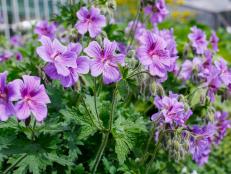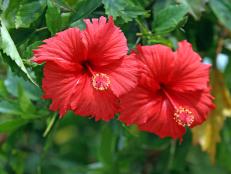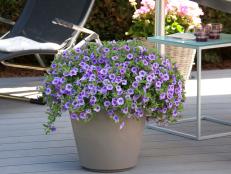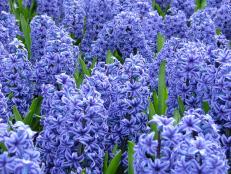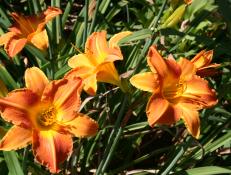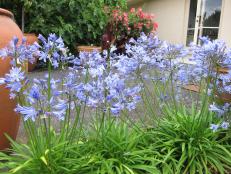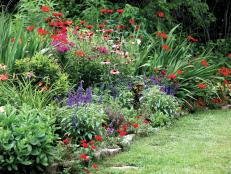How to Grow and Care for Citronella
Do citronella plants repel mosquitoes? There are two different kinds of citronella plants and only one has any effect on pesky insects. But they're both nice to grow.

Balmy summer days bring hordes of hungry mosquitoes. Rather than flee indoors, some gardeners turn to citronella and other plant partners for protection from biting bugs. Do citronella plants repel mosquitos? How can we best grow and care for these lemon-scented herbs?

Shutterstock/rawf8
Essential oils are harvested commercially from citronella grasses.
What Is a Citronella Plant?
Citronella is a plant compound that is produced in varying quantities by citronella grass and its relatives. Citronellol and citronellal are compounds found in essential oil from Ceylon citronella (Cymbopogon nardus) and Java citronella (C. winterianus), two sources of citronella.
The name "citronella grass" is used interchangeably to refer to both species. These fragrant oils are used in diffusers, citronella candles, natural sprays and a wide array of other aromatic products. While close relatives in the lemongrass group (including C. flexuosus, C. citratus and C. pendulus) also produce these compounds, it’s in lesser quantities than true citronella grass.
You may also see the name "citronella plant" on labels of plants that are clearly not grasses. This moniker is shared with lemon-scented geraniums that are also often called "citronella geranium or "citrosa geranium."
They are also referred to as "mosquito plant" and "citronella mosquito plant." The taxonomy on this species is a little fuzzy, with some labelling as Pelargonium x citrosum 'Van Leenii,' P. x asperum or P. graveolens just to name a few. While these geraniums do smell similar to citronella grass, they actually produce smaller quantities of citronellol and citronellal and higher quantities of another botanical compound known as geraniol.
Do Citronella Plants Repel Mosquitoes?
For most of our history, humans have relied on plants and other natural products to discourage biting insects like mosquitoes. There are many accounts from anthropologists and ethnobotanists of people growing plants inside and around their homes, hanging dried leaves and branches from rafters, burning plant parts in fires to create fragrant smoke and treating clothes and skin with plant-based products from these and other species to deter mosquitoes.
Turn Old Glass Bottles Into Citronella Torches
These beautiful citronella torches take less than 10 minutes to make.
Despite their historic uses, modern research suggests using citronella grass and citronella geranium isn’t the most effective way to repel mosquitoes. Various studies conclusively found that simply growing these plants in high-traffic areas, like the porch or patio, simply don’t do much to limit mosquito bites.
While there are many claims to the efficacy of products that contain essential oils, such as citronella oil from lemon grass and geraniol from citronella geraniums, the jury is still out when it comes to scientific evidence. The lack of consensus is due to some problems with the design of the experiments, including differences in species of plant used, essential oil concentration, processing methods, product application, environmental conditions, number and level of hunger of mosquitoes, whether mosquitoes bit the subjects or simply landed on them, time of day (some mosquitoes are more active at night), the number of human subjects and even distribution of participants within groups (apparently age, sex, size, diet, personal grooming and level of physical activity can all impact a person’s attractiveness to mosquitoes).
Some studies suggest that botanical products can effectively repel biting insects for almost an hour, but only at concentrations much higher than most products that are available to consumers. The main problem is that citronellol, citronellal and geraniol are volatile oils that dissipate quickly, meaning that any protection from these oils just doesn’t last very long.
So why not use a higher concentration or even undiluted application for longer-lasting effects? Studies disagree on what a safe concentration is, and each of these herbal products can definitely cause skin irritation and sensitivity. Some authorities recommend applying products with the following ratios at most: 2 percent citronella grass, 0.1 percent lemongrass, 6 percent citronella geranium. But, these rates are generally not effective for repelling mosquitoes. Our understanding of how to safely and effectively use these and other herbal products will change as plant-based repellents become subjected to the same level of rigorous testing as synthetic repellents.
Does this mean you shouldn’t bother planting citronella grass or citronella geranium? Not at all! These are beautiful, fragrant plants that deserve a spot in any plant lover’s garden. Just don’t expect them to eliminate your mosquito problems on their own. To achieve the best bug-repelling results, employ a combined approach.
Mosquitos breed in standing water, so cleaning gutters annually, changing water in birdbaths and turning over wading pools and wheelbarrows are great ways to cut down on their population in your garden. Even if you’re doing everything right, some species of mosquitoes are able to fly several miles in search of food. Wearing long-sleeve shirts and long pants, using an EPA-registered insect repellent and avoiding the outdoors at dawn and dusk (when mosquitoes are most active) are also good ways to avoid bites.
Citronella Plant Care
Both citronella grass and citronella geranium can be grown from seed or purchased from a plant nursery. They can be grown as tender annuals out in the garden or as houseplants on a sunny windowsill. However, these are very different, unrelated species that have different growing requirements.
Growing Citronella Grass
Citronella grass (Cymbopogon nardus or C. winterianus) may be hard to find locally or even from specialty online nurseries. However, grocery stores that specialize in Southeast Asian cuisine may sell stalks without leaves or roots for culinary use. Pop a stalk in a glass of water and wait for roots to develop. Once the stem has rooted, you can pot the plant or plant outside in warm weather.
Grow Citronella Grass from Seed
To grow citronella grass from seed, lightly scatter the seed on the soil surface. Gently press the seed onto the soil to ensure good contact. Don’t cover the seed with soil — citronella seeds will sprout better if it’s exposed to light. Place the pot on a heat mat if you have one to improve the germination rate. You should begin to see seedlings between 1 and 2 weeks after planting.

Shutterstock/wasanajai
Citronella grass is a tropical species that thrives with at least six hours of sunlight a day and a warm environment above 60 degrees. It will grow happily in a pot up on the patio or in a moist but well-drained section of the garden. Remember to bring your plant inside when temperatures drop in the fall.
A mature citronella plant can grow to several feet in height. If you don’t have room for an unwieldy, strappy grass in your home, you can save a smaller division. Just remove a small plantlet (a living section that has both roots and a shoot) from the crown of the plant. Pot up the little plantlet and grow indoors over the winter.
Growing Citronella Geranium
Growing Citronella Geranium From Seed
Timing is everything when growing citrosa geranium and other types of scented geraniums from seed. Here are the steps to growing from seed.
- Start seed indoors by the middle of January for robust seedlings that are ready to plant outdoors in the spring.
- Sow the seed on the soil surface and lightly cover with a fine dusting of potting soil.
- Place the pot on a heat mat with supplemental light to speed up germination.
- Cover the pot with a clear dome or other protective layer to maintain good humidity.
- The seedlings will be ready to transplant into their own 4-inch pots once they have three sets of leaves.
Growing Citronella Geranium in a Pot
While citrosa geranium seed may be tricky to find, potted plants are readily available from nurseries and garden centers during the growing season. Plants may be labeled as mosquito plant. Look for plants that have sturdy stems and healthy white roots that fill the pot.

Shutterstock/Fehmi
Geranium citronellas valued for their flowers and pleasant, citrusy scent, but they don't repel mosquitoes.
Your new citrosa geranium will appreciate being given some room to grow in its new home. Choose a slightly larger pot that has drainage holes in the bottom. Citrosa geranium should do well in a standard potting soil mixture. If you’ve lost plants to overwatering in the past, choose a free mixture that offers good drainage as well as a healthy dose of organic matter.
Look for potting soils that include composted pine bark. Composted pine bark feeds beneficial soil microorganisms that limit damping off and root rot diseases that are especially damaging to Pelargonium.
Overwintering Citronella Geranium
Citrosa geranium will grow happily in full sun and warm temperatures. When the forecast calls for temperatures to dip below 60 degrees, it’s time to bring your tender geranium inside. You can overwinter citrosa geranium as a potted houseplant, as a dormant plant in storage or as a rooted cutting.
20 Mosquito-Repelling Plants 20 Photos
Outsmart mosquitoes by using plants that repel or confuse them.
The easiest overwintering method is to simply bring your potted geranium inside. If the plant was growing in the ground, gently lift the plant, remove the native soil from the roots, pot up in a container and water generously before bringing indoors. Place the pot in a sunny windowsill and water sparingly through the winter. It’s not unusual for scented geraniums to lose their leaves when they move indoors. That’s just a part of how they acclimate to their new environment. Trim out any dead or untidy growth as needed.
How to Grow and Use Scented Geraniums
Pelargoniums, cousins of common garden geraniums, add delightful fragrance to your home and garden.
Dormant geraniums can simply be stored in the garage or a cool basement over the winter. If you choose this method, water sparingly (about once a month) and don’t worry about light. The plants will look puny through the winter, but they should pluck back up within a few weeks of moving back outdoors when warmer weather arrives.
The final method for overwintering citrosa geranium is to grow new plants from stem cuttings. Here are the steps:
- Use clean and sharp hand pruners to collect a 3- or 4-inch section of stem from a healthy branch.
- Remove any foliage from the bottom half of the stem cutting.
- Place the stem cutting in a glass of water and pot up new plants after roots develop.
- Another technique would be to dip the bottom of the stem cutting in rooting hormone (available from most garden centers and nurseries), then gently push the bottom of the cutting into moist potting soil. Roots should begin to develop within a month or so.









